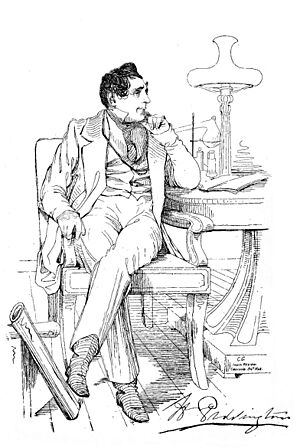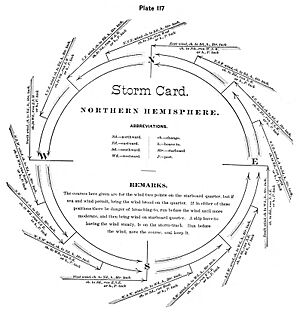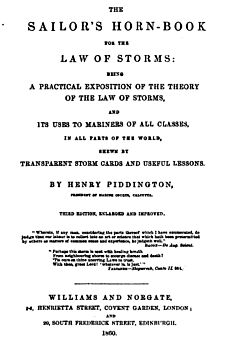Henry Piddington facts for kids
Henry Piddington (1797–1858) was an English sea captain and scientist. He sailed in places like East India and China. Later, he lived in Bengal, India. There, he worked at a museum and studied many scientific topics. He is best known for his important work on tropical storms and hurricanes. In 1848, he noticed that winds in these storms moved in a circle around a calm center. He then created the word cyclone to describe them.
Contents
A Life of Science and Discovery
Henry Piddington was born in England in 1797. His family ran an inn. This is where he likely met many sailors. He became a ship captain himself. By 1824, he was living in Bengal, India. He settled in Calcutta around 1831. There, he became very interested in science.
He worked in sugar refining for a while. He was also a secretary for the Agricultural and Horticultural Society of India. In 1844, he became the curator of a new museum. This was the Museum of Economic Geology in Calcutta. For the next ten years, he wrote many scientific papers. These papers covered topics like geology, botany, and weather.
Understanding Storms: The Law of Storms
In 1833, a big cyclone hit Calcutta. At first, Piddington did not pay much attention. But in 1838, he learned about the "Law of Storms." This idea came from Lieutenant-Colonel William Reid. This made Piddington think about his own sailing experiences. He started looking at old ship logs. These logs were like diaries kept by sailors. They recorded weather and ship movements.
The government helped him by sending storm records. Piddington studied these records carefully. He noticed something important about storms. They had a calm center, like the eye of a storm. Around this center, the winds moved in a spiral. In the northern part of the world, they spun counter-clockwise. In the southern part, they spun clockwise.
He wrote many papers about his findings. In 1844, he published a book. It was called The Horn-Book for the Law of Storms for the Indian and China Seas. In 1848, he released a new version. In this book, he introduced the word "cyclone." He got the word from the Greek word kyklos. This word means "circle" or "ring." It described the circular winds he observed.
His "horn book" included a special "storm card." This was a clear sheet with a diagram of a cyclone. Sailors could place it on a map. This helped them compare wind directions. They could then figure out if a cyclone was near. This helped them steer their ships to safety. The book became very popular.
Piddington also gave important advice. In 1853, he warned against building a port in a certain area. This was Port Canning, near Calcutta. He said it was too open to storms. The port was built there anyway. After Piddington passed away, a big storm hit it in 1867. The port was badly damaged and later abandoned. This showed how right Piddington had been.
Other Important Roles
Besides his scientific work, Piddington held other jobs. He was a secretary for the Agricultural and Horticultural Society. He also served as Her Majesty's Coroner of Calcutta. This meant he investigated deaths. He was also a president of marine courts. These courts looked into issues related to ships and the sea.
His Family Life
Henry Piddington married Jeanne Julie Josephine Gaultier de Lavalette. They had three sons. Piddington is buried in the Chandannagar cemetery in India.
Mentioned in Literature
Henry Piddington's work has even appeared in books. The famous author Amitav Ghosh wrote about him. This was in his novel The Hungry Tide. Even though it's a story, Ghosh describes Piddington's life well. The book talks about Piddington's warning about the Port Canning project. It also mentions the storm that later destroyed it. Ghosh wrote that Piddington "fell in love with storms." This shows how dedicated he was to studying them.
Published Works
Henry Piddington wrote many scientific papers. He also published several important books.
Books on Storms and Plants
- The Horn-book for the Law of Storms for the Indian and China Seas, 1844
- The Sailor's Horn-book for the Law of Storms, 1848 (This book had many editions.)
- An English index to the plants of India 1832




